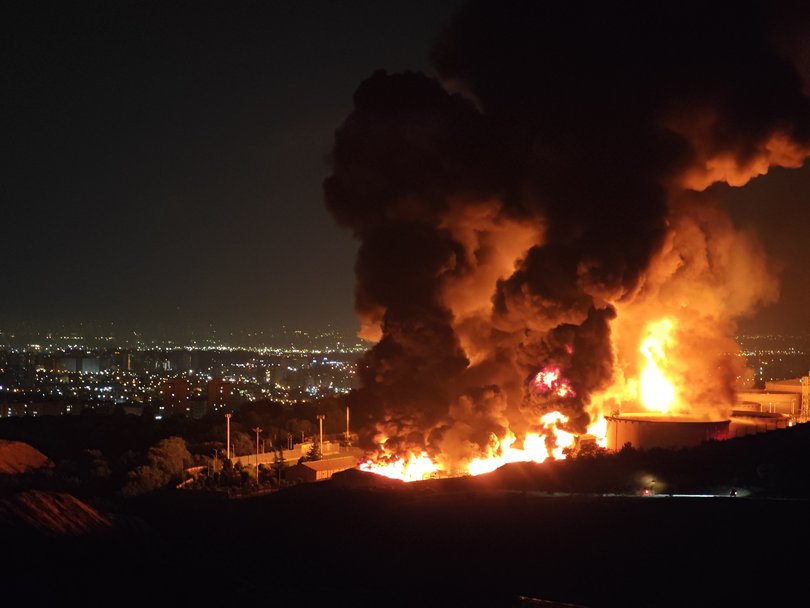JACKSON HEWETT: Middle East conflict rattles economic outlook as oil prices surge

Israel’s attack on Iran’s nuclear infrastructure has sent oil prices sharply higher, plunging the world into a fresh wave of geopolitical instability amid already heightened economic uncertainty.
Whether the conflict escalates into all-out war may hinge on whether a 2.5-magnitude seismic event northeast of Qom confirms the destruction of Iran’s most heavily fortified nuclear site, the Fordow facility, which is buried deep within a mountain.
If the site has indeed been struck and was not destroyed by Mossad infiltration, the most plausible method would have involved deployment of a US Air Force B-52 bomber armed with a Massive Ordnance Penetrator, a precision bunker-busting weapon designed to reach such fortified targets. That would mark direct American involvement in the conflict.
Sign up to The Nightly's newsletters.
Get the first look at the digital newspaper, curated daily stories and breaking headlines delivered to your inbox.
By continuing you agree to our Terms and Privacy Policy.Richard Nephew, a senior fellow at Columbia University’s Center on Global Energy Policy and former National Security Council adviser on Iran during the Obama administration, who later helped negotiate the Iran nuclear deal under President Biden, told the Columbia Energy Exchange podcast the Fordow facility housed up to 3000 centrifuges capable of enriching uranium to weapons-grade levels.
“The fact we don’t know where Iran’s store of enriched uranium is and whether or not that’s been rendered unusable by the Israelis is incredibly nerve-wracking,” Mr Nephew said.
“Until we know that, we are at risk that the Israelis have hit a large part of the nuclear program, but not taken out the thing that is most important.”
Mr Nephew said Iran was “five to six days away” from producing weapons-grade uranium and had stopped cooperating with international inspectors.
“Frankly, the Israelis decided the risk of Iran getting much closer to nuclear weapons was simply too great to deal with,” he said.
If Fordow has been destroyed, Iran’s leadership may see no other option than to retaliate against the oil facilities of its US-aligned neighbours, given the at least tacit permission to attack. If it was indeed a US B-52 that dropped the bomb on its prized nuclear site, Iran may consider American military installations in Bahrain, Egypt, Iraq, Jordan, Kuwait, Qatar, Saudi Arabia and the United Arab Emirates as legitimate targets for reprisal.
Such retaliation would render the Strait of Hormuz, a narrow 39-kilometre-wide chokepoint and the exit for seaborne oil and gas from the Middle East, effectively inoperable. Around 25 per cent of the world’s seaborne oil trade flows through the Strait, which connects the Persian Gulf to the Gulf of Oman and the open ocean.
The region produces 26 million barrels of crude oil per day. While Saudi Arabia and the UAE have built pipelines to bypass the Strait, their capacity is limited. According to Kate Dourian from the Arab Gulf States Institute, these alternatives would not be sufficient to offset a global supply shock.
Qatar, one of the world’s largest gas exporters, relies on the Strait to ship 77 million metric tonnes of liquefied natural gas annually. Abu Dhabi’s terminal exports another six million tonnes through the same corridor. Combined, the Strait accounts for 25 per cent of global LNG trade.

Karen Young, a senior research scholar at the Center on Global Energy Policy, told the Columbia Energy Exchange podcast that oil markets had so far remained composed, noting the price of crude had risen just 10 per cent to $US73 in response to the attacks. She said the spike was comparable to the 2019 Iran-backed Houthi drone attacks on Saudi oil infrastructure.
Ms Young added that since 2023, oil markets had begun to decouple conflict risk from price movements, thanks to the ability of countries like Saudi Arabia to bring more supply to market. But in the case of a direct attack on infrastructure or a shutdown of transit through the Strait of Hormuz, that stability could rapidly erode.
Mr Nephew said Iran’s leadership would now be weighing its options. One of Israel’s stated goals, he noted, was to force regime change from the ruling Ayatollahs. To do that, Israel might next target Iran’s primary source of wealth, its oil and gas.
“If the Israel attack profile continues along regime change lines, I think it’s almost inevitable that you’re going to see attacks on pipeline infrastructure, oil refineries, production sites,” he said.
“In that sort of environment, the Iranians have been pretty clear: If we can’t export oil, no one will.”
He added that Iran might decide not to waste missiles on Israel’s Iron Dome defences, and instead “try and get their pound of flesh” by targeting other assets.
“That absolutely can involve US bases and US enterprises in the Gulf, as well as oil and gas infrastructure being held by the Saudis, Emiratis or others.”
Until the recent escalation, oil prices had been declining steadily since May, having fallen by more than half from their $US130 per barrel peak during Russia’s invasion of Ukraine.
Iran holds about 9 per cent of the world’s proven oil reserves and exports between 1.5 and 2 million barrels per day, mostly to China, which continues to ignore longstanding US sanctions.
China remains the world’s largest oil importer, not only for fuel but for industrial uses such as polyester production, even as it reduces demand via electric vehicle uptake. A disruption to Iranian supply may not pull China into the conflict, but it would require Beijing to source alternative fuel quickly, placing significant upward pressure on global markets.
The US, meanwhile, has depleted its strategic petroleum reserve by 50 per cent since 2009 to 382 million barrels. While US shale producers could ramp up output under higher prices, any increase would lag the initial shock.
AMP’s Shane Oliver said the rise in global crude prices could push Australian petrol prices up by 12 cents per litre.
Australia’s energy prices have been driven by the increased price of gas globally, as gas is used to fill in at peak times of energy use. Any jump in LNG would be felt here.
Higher energy prices would ripple across an already fragile global economy, still contending with the inflationary effects of Donald Trump’s tariff policies. Companies absorbing tariff levies could see further margin erosion, while central banks may be forced to delay interest rate cuts to avoid reigniting inflation.
In the longer term, American approval of an attack on a sovereign state, executed just days before key trade talks, may harden China’s belief that Washington negotiates in bad faith. That could set back progress on tariff agreements and add further drag to global growth.
Iran has since declared it will cease cooperation with the International Atomic Energy Agency, making its nuclear ambitions less transparent and potentially more dangerous. Unless Israel succeeds in achieving both regime change and complete elimination of Iran’s nuclear capabilities, Tehran may now be more motivated than ever to become a nuclear power.

